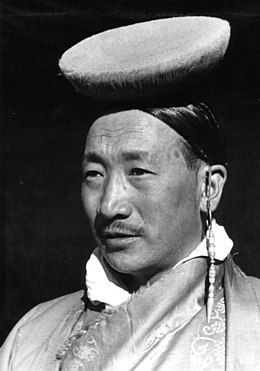Ringang
 From Wikipedia (Fr) - Reading time: 3 min
From Wikipedia (Fr) - Reading time: 3 min
| Naissance |
ou |
|---|---|
| Décès | |
| Activité | |
| Enfant |
Chang Ngopa Dorje Ngodup (d) |
| Parentèle |
Tsering Yangdzom (petite-fille) |
(Chhangngöpa) Ringang ou Rinchhengang, de son nom personnel (Chang Ngopa) Rinzin Dorje (tibétain : (བྱང་ངོས་པ)་རིན་སྒང ; རིག་འཛིན་རྡོ་རྗེ ; Wylie : (byang ngos pa) rin sgang ; rig 'dzin rdo rje) (1901 / 1904 - ) est un homme politique et ingénieur tibétain. Il appartient à la noblesse tibétaine[1].
Famille
[modifier | modifier le code]Il est le second fils de Ringang Kalsang Nyima, un ancien mipön (maire) de Lhassa[1].
Rinchhengang est en réalité le nom du domaine familial près de Tolung, au nord de Lhassa[1].
Études
[modifier | modifier le code]
Ringang est l'un des « quatre Tibétains de Rugby », jeunes garçons envoyés en 1913 en Angleterre pour y faire des études secondaires et y acquérir une formation professionnelle, les trois autres étant Kyibu II, Möndro et Gongkar. Arrivés en Angleterre le , ils furent tous admis à l'académie militaire de Heathend, puis à la public school de Rugby. En juin, avec leur mentor, Lungshar, ils furent reçus en audience par le couple royal.
Décrit comme un élève brillant à Rugby, Ringang obtint ensuite un diplôme de génie électrique et hydroélectrique En 1918, il rentra au Tibet. En 1919, il retourna en Angleterre pour un complément de formation, puis en revint en 1924, apportant avec lui l'équipement nécessaire à la construction de la centrale hydroélectrique de la vallée de Dodé[1],[2].
Ces séjours ont été approuvés par Sir Charles Bell et le 13e dalaï-lama[1].
Carrière
[modifier | modifier le code]
À partir de 1921, il travailla comme fonctionnaire du gouvernement du Tibet. Il jouissait de la confiance du 13e dalaï-lama[1].
Il créa la centrale hydroélectrique de la vallée de Dodé, située au nord de Lhassa, la première centrale hydroélectrique du Tibet[3]. Il commença la construction en 1924 et mit en service la centrale en 1927[4].
En 1933, il fut nommé fonctionnaire municipal (Nyertshangnga) et dzongpön de Burang. Il ne résidait cependant pas au dzong de Burang et continuait à vivre à Lhassa. En 1935, il créa Drapchi Lekhung, la première usine hydroélectrique, située à Drapchi près de Lhassa [1].
Dans les années 1930, il travailla comme interprète en anglais auprès du bureau du Kashag et, en 1933, auprès de Frederick Williamson (en). En 1937, il fut promu officiel de 4e grade du gouvernement. En , il devint l'assistant du bureau des Affaires étrangères du Tibet. Il mourut 18 mois plus tard[1].
Notes et références
[modifier | modifier le code]- (en) brève description physique et des photographies, site Tibet Album, British photography in Central Tibet 1920-1950
- ↑ (en) Harris, Clare & Tsering Shakya, Seeing Lhasa: British depictions of the Tibetan capital 1936-1947, (2003), (ISBN 978-1932476040), p. 40, 91, 116-117 : « Ringang excelled in his studies at Rugby and, as noted earlier, went on to graduate in electrical engineering and return to Tibet in 1924 and set about installing electricity in Lhasa. » [...] « (arranged by Sir Charles Bell and the 13th Dalai Lama) ».
- ↑ (en) W. D. Shakabpa, Derek F. Maher, One hundred thousand moons, volume 1, p. 804.
- ↑ (en) Wolfgang Bertsch, The Production of Tibetan Banknotes, The Tibet journal, Library of Tibetan Works & Archives, 24 (1), 1999, p. 30 : « In that period Rigzin Dorje Ringang who had received his education at Rugby in England and who had studied electro-engineering at the University of London and in Birmingham, was working as chief engineer for the mint and was also in charge of the hydro-electric power station in the Dode valley. In 1924 he ordered a 125 HP generator and coining presses from British firms. In 1927 the generator was installed at the hydro-electric power station in the Dode valley, while the modern machinery was destined for the extension of the Trabshi mint, north of Lhasa, which was reopened in November 1931 with Tsarong. »
- (nl) Cet article est partiellement ou en totalité issu de l’article de Wikipédia en néerlandais intitulé « Ringang » (voir la liste des auteurs).
 KSF
KSF